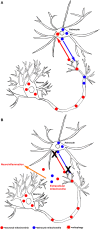Mitochondria-Derived Damage-Associated Molecular Patterns in Neurodegeneration
- PMID: 28491064
- PMCID: PMC5405073
- DOI: 10.3389/fimmu.2017.00508
Mitochondria-Derived Damage-Associated Molecular Patterns in Neurodegeneration
Abstract
Inflammation is increasingly implicated in neurodegenerative disease pathology. As no acquired pathogen appears to drive this inflammation, the question of what does remains. Recent advances indicate damage-associated molecular pattern (DAMP) molecules, which are released by injured and dying cells, can cause specific inflammatory cascades. Inflammation, therefore, can be endogenously induced. Mitochondrial components induce inflammatory responses in several pathological conditions. Due to evidence such as this, a number of mitochondrial components, including mitochondrial DNA, have been labeled as DAMP molecules. In this review, we consider the contributions of mitochondrial-derived DAMPs to inflammation observed in neurodegenerative diseases.
Keywords: damage-associated molecular pattern; mitochondria; neurodegeneration; neuroinflammation; sterile inflammation.
Figures

References
Publication types
Grants and funding
LinkOut - more resources
Full Text Sources
Other Literature Sources
Research Materials

